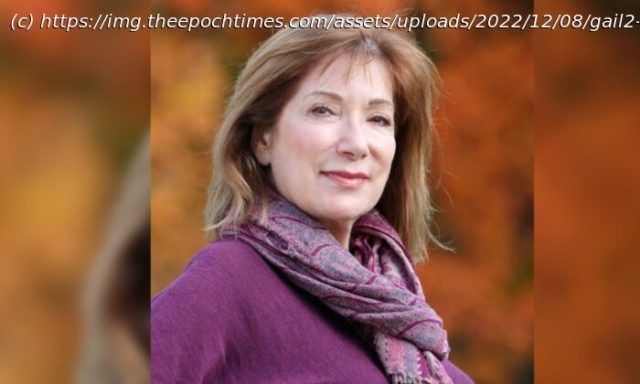Array
For 54 years, China was not on Gail Rachlin’s radar. Then, in the fall of 1997, it entered her life unexpectedly.
At a health expo at New York City’s Javits Center, she was looking for business opportunities and health solutions for herself and noticed a young man at a booth. A former public relations (PR) executive, she had moved on to running her own PR business.
She was good at reading people, and his energy stood out to her.
“What do you sell?” she walked up to him, thinking it was vitamin pills.
“No,” the man laughed, “This is free.”
“Nothing’s free in New York!” she replied.
Sure enough, the young man taught her an exercise of Falun Gong, free of charge. Also known as Falun Dafa, Falun Gong is an ancient belief rooted in the traditional Chinese culture of Buddhism and Taoism. It is based on the tenets of truthfulness, compassion, and forbearance and has a set of five slow-moving meditative exercises.
Immediately, Rachlin felt a surge of energy in her body. So she learned more of the exercises and took up the practice. An ovarian cancer survivor since 29, she had been looking for alternative health practices.
In a few months, Rachlin was diagnosed with breast cancer. Between getting surgeries and doing the Falun Gong exercises, she chose the latter. Two months later, she went back to the doctor, who confirmed that the malignant lump had shrunk to less than a quarter in size and wasn’t a concern anymore. Soon afterward, she fully recovered.
“I became a real believer because it was just amazing,” Rachlin, now 79, told The Epoch Times, referring to the spiritual practice.
Together with another seven women, all Chinese Americans, who went to Riverside Park at 105th Street to do the Falun Gong exercises together, she began promoting the practice locally.Trip to Beijing and Changchun
In August 1998, a friend got Rachlin a contract to visit Beijing to try and attract Chinese businesses to attend an expo at the World Trade Center in New York City.
For that purpose, she had meetings with Chinese officials in Beijing. During the first week of her visit, when she and three officials were chatting about working out, Rachlin said, “I do exercises, too!”
“It was my first time meeting Chinese communist government [officials]. I told them I was practicing—I just started the year before—Falun Gong, and they all looked at each other, literally froze,” she recalled.
“I was very proud. I didn’t realize anything; nobody said anything to me before,” she added. “As the naïve American, I mentioned I was practicing [Falun Gong], and my wonderful health changes.”
After some awkward silence, one official with the English name Bill said he practiced qigong too for quite a few years. Then the group changed topics.
Rachlin at the time didn’t know then that many people in China were drawn to the healing effect of qigong—physical and breathing exercises connected to traditional Chinese culture—in the 1980s and 1990s. Qigong was a fad in Chinese society.
Li Hongzhi, the founder of Falun Gong, introduced the practice to the public in 1992 as a form of qigong. By 1998, Falun Gong had become the most popular qigong known to the Chinese population. By July 1999, official estimates placed the number of adherents at 70 million to 100 million.
The following week, she said she sensed a heightened curiosity from the Chinese officials as they arranged for her to tour some Chinese manufacturing factories: “They were all looking at me, like, what is she doing here? What is she going to do?”
It was not until later during the trip that she understood why.
Rachlin took a side trip to Changchun, the capital of Jilin Province in northeast China, for a personal reason: the city is the hometown of Falun Gong’s founder, where the practice spread through word of mouth. There, she participated in group exercises; she estimated 2,000 people at one park and 5,000 in another.
“I was blown away,” she said, comparing the number to her local group of eight in Manhattan.
Falun Gong adherents in Changchun were amazed to know that an American shared their belief. At Jilin University, she met some and had tea with them. They chatted through her interpreter. She still remembered some of the stories that the Chinese Falun Gong practitioners shared with her.
One resonated with her deeply.
A woman, 65, a retired medical professional, said her doctor had told her five years ago that she had only six months to live. After that, she took up Falun Gong and thought that if she was going to die, she might as well be spiritual and peaceful. Rachlin specifically remembered that she used the word “peaceful.” The woman said she survived her terminal illness thanks to Falun Gong.
Rachlin still remembered that the woman had short gray hair. But at the roots, an inch was black. “Can you imagine all the roots were black? It was her hair growing,” Rachlin said.
“I was like, ‘What happened with that? What is this?’
“And she said, ‘I think I’m doing better.’ She was so cute,” Rachlin recalled.
In Changchun, other Falun Gong adherents warned Rachlin to “be careful.” They told her that police had been showing unusual interest in the group lately by frequently appearing at exercises in public parks and questioning different practitioners. She recalled the conversation with the Chinese communist officials and understood why Bill later asked her in private her reason for practicing Falun Gong.
After six weeks in China, Rachlin returned to New York without securing any Chinese visitors to the expo. She realized years later that mentioning Falun Gong may have partially contributed to that outcome.Things Get Personal
Rachlin’s life returned to normal, and she continued to spread the word about Falun Gong in New York City. When news broke on April 25, 1999, that over 10,000 Falun Gong adherents peacefully protested outside of the central Chinese Communist Party (CCP) compound in Beijing calling for an end to the regime’s escalated suppression of the practice, Rachlin started using her company to create videos and press materials to tell the Falun Gong’s side of the story.
A few months later, the persecution officially began and swept the entire country. Many volunteer organizers of group exercise sites similar to the ones Rachlin had attended in Changchun were arrested overnight.
Having visited Changchun and knowing Falun Gong practitioners in China, it felt close to home.
“This is my family. How could anybody touch them? This is not right,” she said.
“So, it was a personal thing for me. It really was, and I’ve always felt that. I still do.”
Thus, given her professional public relations background, she volunteered as a spokesperson for Falun Gong.
“I had no idea about China before. I didn’t know about the Cultural Revolution.
Домой
United States
USA — China ‘This Is My Family’: An American’s Story Defending Freedom in China and...






